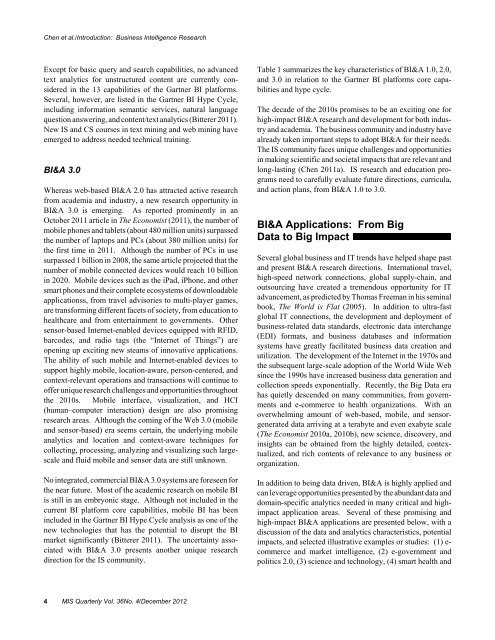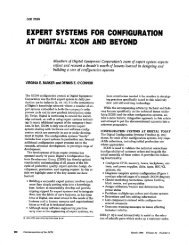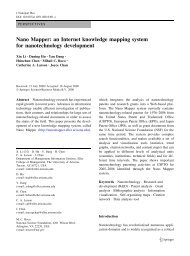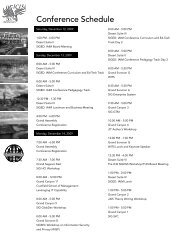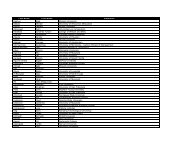business intelligence and analytics: from big data to big impact
business intelligence and analytics: from big data to big impact
business intelligence and analytics: from big data to big impact
You also want an ePaper? Increase the reach of your titles
YUMPU automatically turns print PDFs into web optimized ePapers that Google loves.
Chen et al./Introduction: Business Intelligence ResearchExcept for basic query <strong>and</strong> search capabilities, no advancedtext <strong>analytics</strong> for unstructured content are currently consideredin the 13 capabilities of the Gartner BI platforms.Several, however, are listed in the Gartner BI Hype Cycle,including information semantic services, natural languagequestion answering, <strong>and</strong> content/text <strong>analytics</strong> (Bitterer 2011).New IS <strong>and</strong> CS courses in text mining <strong>and</strong> web mining haveemerged <strong>to</strong> address needed technical training.BI&A 3.0Whereas web-based BI&A 2.0 has attracted active research<strong>from</strong> academia <strong>and</strong> industry, a new research opportunity inBI&A 3.0 is emerging. As reported prominently in anOc<strong>to</strong>ber 2011 article in The Economist (2011), the number ofmobile phones <strong>and</strong> tablets (about 480 million units) surpassedthe number of lap<strong>to</strong>ps <strong>and</strong> PCs (about 380 million units) forthe first time in 2011. Although the number of PCs in usesurpassed 1 billion in 2008, the same article projected that thenumber of mobile connected devices would reach 10 billionin 2020. Mobile devices such as the iPad, iPhone, <strong>and</strong> othersmart phones <strong>and</strong> their complete ecosystems of downloadableapplicationss, <strong>from</strong> travel advisories <strong>to</strong> multi-player games,are transforming different facets of society, <strong>from</strong> education <strong>to</strong>healthcare <strong>and</strong> <strong>from</strong> entertainment <strong>to</strong> governments. Othersensor-based Internet-enabled devices equipped with RFID,barcodes, <strong>and</strong> radio tags (the “Internet of Things”) areopening up exciting new steams of innovative applications.The ability of such mobile <strong>and</strong> Internet-enabled devices <strong>to</strong>support highly mobile, location-aware, person-centered, <strong>and</strong>context-relevant operations <strong>and</strong> transactions will continue <strong>to</strong>offer unique research challenges <strong>and</strong> opportunities throughoutthe 2010s. Mobile interface, visualization, <strong>and</strong> HCI(human–computer interaction) design are also promisingresearch areas. Although the coming of the Web 3.0 (mobile<strong>and</strong> sensor-based) era seems certain, the underlying mobile<strong>analytics</strong> <strong>and</strong> location <strong>and</strong> context-aware techniques forcollecting, processing, analyzing <strong>and</strong> visualizing such largescale<strong>and</strong> fluid mobile <strong>and</strong> sensor <strong>data</strong> are still unknown.No integrated, commercial BI&A 3.0 systems are foreseen forthe near future. Most of the academic research on mobile BIis still in an embryonic stage. Although not included in thecurrent BI platform core capabilities, mobile BI has beenincluded in the Gartner BI Hype Cycle analysis as one of thenew technologies that has the potential <strong>to</strong> disrupt the BImarket significantly (Bitterer 2011). The uncertainty associatedwith BI&A 3.0 presents another unique researchdirection for the IS community.Table 1 summarizes the key characteristics of BI&A 1.0, 2.0,<strong>and</strong> 3.0 in relation <strong>to</strong> the Gartner BI platforms core capabilities<strong>and</strong> hype cycle.The decade of the 2010s promises <strong>to</strong> be an exciting one forhigh-<strong>impact</strong> BI&A research <strong>and</strong> development for both industry<strong>and</strong> academia. The <strong>business</strong> community <strong>and</strong> industry havealready taken important steps <strong>to</strong> adopt BI&A for their needs.The IS community faces unique challenges <strong>and</strong> opportunitiesin making scientific <strong>and</strong> societal <strong>impact</strong>s that are relevant <strong>and</strong>long-lasting (Chen 2011a). IS research <strong>and</strong> education programsneed <strong>to</strong> carefully evaluate future directions, curricula,<strong>and</strong> action plans, <strong>from</strong> BI&A 1.0 <strong>to</strong> 3.0.BI&A Applications: From BigData <strong>to</strong> Big ImpactSeveral global <strong>business</strong> <strong>and</strong> IT trends have helped shape past<strong>and</strong> present BI&A research directions. International travel,high-speed network connections, global supply-chain, <strong>and</strong>outsourcing have created a tremendous opportunity for ITadvancement, as predicted by Thomas Freeman in his seminalbook, The World is Flat (2005). In addition <strong>to</strong> ultra-fastglobal IT connections, the development <strong>and</strong> deployment of<strong>business</strong>-related <strong>data</strong> st<strong>and</strong>ards, electronic <strong>data</strong> interchange(EDI) formats, <strong>and</strong> <strong>business</strong> <strong>data</strong>bases <strong>and</strong> informationsystems have greatly facilitated <strong>business</strong> <strong>data</strong> creation <strong>and</strong>utilization. The development of the Internet in the 1970s <strong>and</strong>the subsequent large-scale adoption of the World Wide Websince the 1990s have increased <strong>business</strong> <strong>data</strong> generation <strong>and</strong>collection speeds exponentially. Recently, the Big Data erahas quietly descended on many communities, <strong>from</strong> governments<strong>and</strong> e-commerce <strong>to</strong> health organizations. With anoverwhelming amount of web-based, mobile, <strong>and</strong> sensorgenerated<strong>data</strong> arriving at a terabyte <strong>and</strong> even exabyte scale(The Economist 2010a, 2010b), new science, discovery, <strong>and</strong>insights can be obtained <strong>from</strong> the highly detailed, contextualized,<strong>and</strong> rich contents of relevance <strong>to</strong> any <strong>business</strong> ororganization.In addition <strong>to</strong> being <strong>data</strong> driven, BI&A is highly applied <strong>and</strong>can leverage opportunities presented by the abundant <strong>data</strong> <strong>and</strong>domain-specific <strong>analytics</strong> needed in many critical <strong>and</strong> high<strong>impact</strong>application areas. Several of these promising <strong>and</strong>high-<strong>impact</strong> BI&A applications are presented below, with adiscussion of the <strong>data</strong> <strong>and</strong> <strong>analytics</strong> characteristics, potential<strong>impact</strong>s, <strong>and</strong> selected illustrative examples or studies: (1) e-commerce <strong>and</strong> market <strong>intelligence</strong>, (2) e-government <strong>and</strong>politics 2.0, (3) science <strong>and</strong> technology, (4) smart health <strong>and</strong>4 MIS Quarterly Vol. 36No. 4/December 2012


